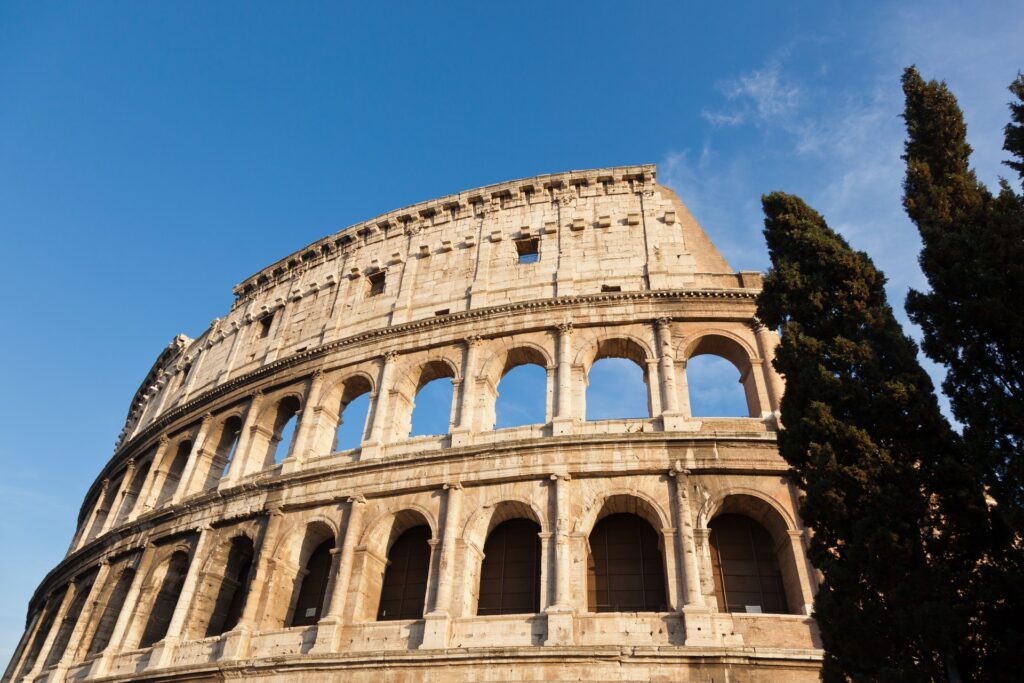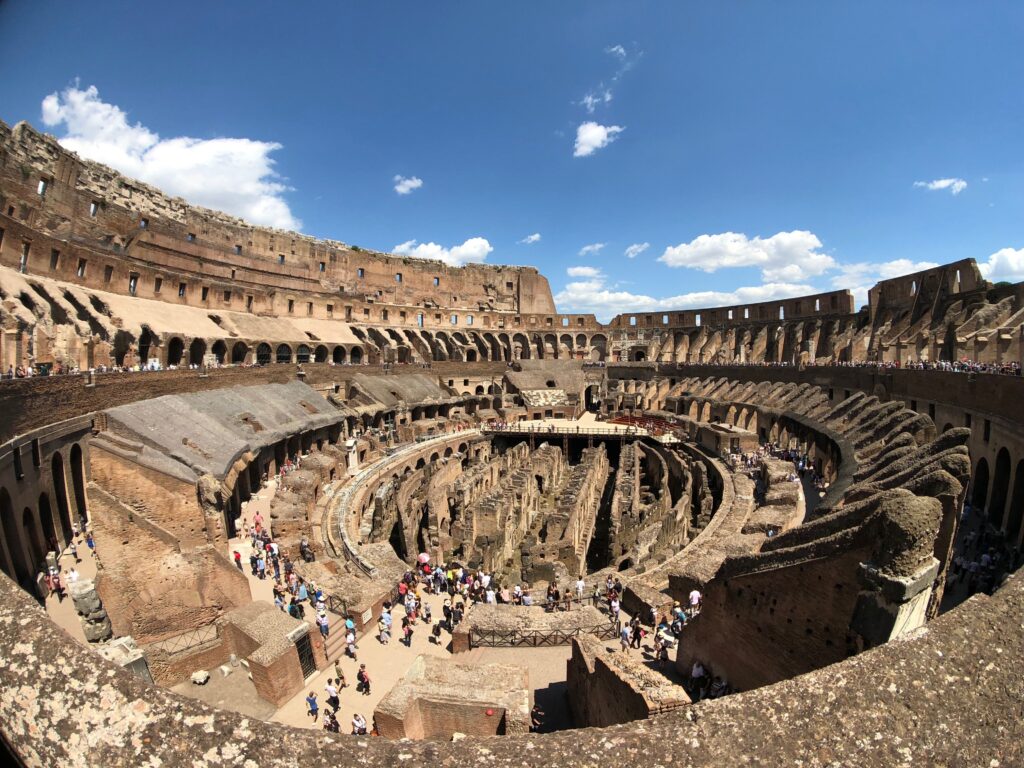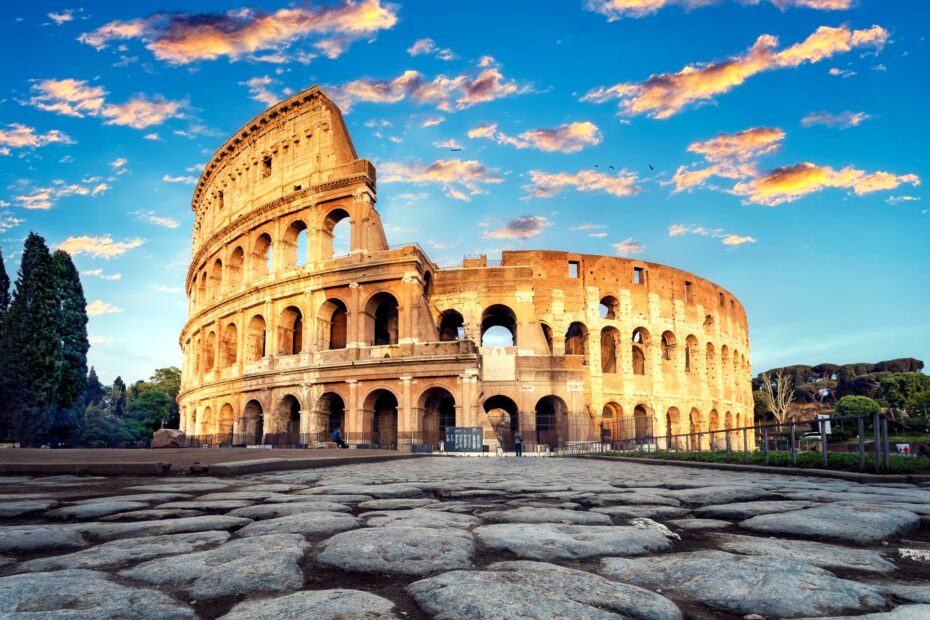Il Colosseo non è solo un’antica meraviglia: è il cuore della storia di Roma e un simbolo del suo lascito eterno. Per quasi 2.000 anni, questo monumentale anfiteatro ha catturato l’immaginazione del mondo con le sue incredibili storie e la sua architettura mozzafiato.
Ma quanto conosci veramente il Colosseo? Certo, è iconico, ma sotto i suoi archi si nascondono segreti affascinanti e fatti sorprendenti che daranno vita alla tua visita.In questo articolo, sveleremo alcuni dei dettagli più intriganti del Colosseo, dal suo ingegnoso design agli eventi epici che ha ospitato.
Che tu stia pianificando la tua avventura romana o sia semplicemente curioso di conoscere questa meraviglia storica, finirai per apprezzarne ancora di più il fascino senza tempo.
Consiglio utile: Pensando di visitare il Colosseo? Salva questo articolo per una rapida consultazione e scopri i nostri tour ROME SWEET R(H)OME, valutati al top, per un’esperienza indimenticabile.
1. The Colosseum Was Built in Just 8 Years
The Colosseum, a marvel of ancient Roman engineering, was completed in an astonishing eight years. Construction began in 72 AD under Emperor Vespasian and was finished in 80 AD by his son Titus.
This rapid pace was made possible by the use of tens of thousands of skilled workers, including engineers, stonemasons, and laborers. They used innovative techniques and tools, such as cranes and pulleys, to lift massive stones into place. Materials like travertine limestone, tuff, and concrete were sourced locally, speeding up the process.
The result? A colossal amphitheater that has stood for nearly two millennia, showcasing the efficiency and ingenuity of Roman engineering. Today, it remains one of the most iconic symbols of the ancient world.
2. The Largest Amphitheater Ever Built is Colosseum
The Colosseum holds the title of the largest amphitheatre ever constructed in the ancient world. Spanning 189 meters long, 156 meters wide, and standing 48 meters tall, its sheer size is awe-inspiring. The elliptical structure covers approximately 24,000 square meters—equivalent to three and a half football fields.
Designed to host over 50,000 spectators, the Colosseum featured tiered seating that ensured everyone had a clear view of the action. The layout was meticulously planned, with 80 arched entrances allowing for quick and efficient entry and exit.
3. Beyond Gladiator Fights: The Colosseum Hosted Animal Hunts and Naval Battles
The Colosseum wasn’t just a stage for gladiator battles; it also hosted extravagant events to showcase the power and wealth of the Roman Empire. One of the most thrilling spectacles was venationes, or animal hunts, where exotic creatures like lions, elephants, and crocodiles were brought from across the empire. These events often pitted animals against each other or against skilled hunters, captivating thousands of spectators.
Even more astonishing were the naumachiae, or mock naval battles. The Colosseum’s underground chambers could be flooded to create a temporary lake, allowing ships to reenact famous sea battles. These shows were rare but demonstrated the engineering genius of ancient Rome.
4. Ingenious Design: The Colosseum Managed 50,000 Spectators
The Colosseum was designed to accommodate and efficiently manage massive crowds of up to 50,000 spectators. Its 80 arched entrances allowed people to enter and exit quickly, a feature so effective it’s still studied in modern stadium design.
The seating arrangement was highly organized, reflecting Roman social hierarchy. Senators and VIPs sat closest to the action, while ordinary citizens and slaves were seated higher up. The layout ensured everyone had a clear view of the performances.
Roman engineers also included wide corridors and staircases, allowing for smooth crowd movement during events.
5. The True Cost of Roman Entertainment
The Colosseum’s grand spectacles came at a devastating cost. Thousands of gladiators, prisoners, and enslaved people lost their lives in violent battles staged for the entertainment of Roman citizens. These fights were not just combat; they were elaborate performances designed to showcase Rome’s power and brutality.
Animals also suffered heavily, with exotic creatures like lions, elephants, and bears imported from distant lands to be hunted or killed in front of massive crowds. It’s estimated that over 1 million animals died in these events during the height of the Colosseum’s use.
6. The Colosseum’s Upper Tiers Offer Panoramic Views of Ancient Rome
The upper tiers of the Colosseum, originally reserved for Rome’s lower classes, now provide visitors with breathtaking views of the ancient city. From this vantage point, you can take in the vast scale of the Colosseum itself, as well as nearby landmarks like the Roman Forum and Palatine Hill.
These upper levels were ingeniously designed to accommodate large crowds while ensuring visibility of the arena below. Today, standing where thousands once gathered offers a unique perspective on both the architecture of the Colosseum and the city it dominates. Accessing the upper tiers gives you a deeper appreciation for Rome’s history and its enduring legacy.
7. The Colosseum’s Underground Chambers Were Built After Its Opening
The Colosseum’s underground chambers, called the hypogeum, were not part of the original structure. They were added under Emperor Domitian’s reign, shortly after the Colosseum opened in 80 AD. These chambers included tunnels, animal pens, and holding cells, revolutionizing how games were staged by allowing animals and gladiators to appear dramatically in the arena via trapdoors and lifts.
8. A Massive Earthquake in 1349 Caused the Colosseum’s Partial Collapse
In 1349, a devastating earthquake struck Rome, causing the southern side of the Colosseum to collapse. The earthquake destabilized the amphitheater’s foundation and led to the removal of large amounts of stone, which were repurposed for building projects around the city.
This natural disaster is a major reason why the Colosseum appears as a partially ruined structure today, offering a glimpse into the challenges it has faced over the centuries.
9. Its Real Name Is Not the Colosseum
The structure we know as the Colosseum was originally called the Flavian Amphitheater, named after the Flavian dynasty that commissioned its construction. The name “Colosseum” is believed to have come later, inspired by a colossal statue of Emperor Nero that once stood nearby.
Though the original statue is gone, the nickname endured, becoming the iconic name recognized around the world today.
10. Planning a Visit to the Colosseum Is Easier Than Ever with Maestro Discover Italy
Maestro Discover Italy offers expertly designed tours to help you explore the Colosseum without the stress of planning. With guided access to must-see areas like the underground chambers and upper tiers, you’ll experience the history and architecture of this iconic landmark in-depth.
Their Rome tours also ensure you skip long lines and enjoy a seamless journey, making your visit both enriching and hassle-free.
Il Colosseo non è solo un’antica meraviglia: è il cuore della storia di Roma e un simbolo del suo lascito eterno. Per quasi 2.000 anni, questo monumentale anfiteatro ha catturato l’immaginazione del mondo con le sue incredibili storie e la sua architettura mozzafiato.
Ma quanto conosci veramente il Colosseo? Certo, è iconico, ma sotto i suoi archi si nascondono segreti affascinanti e fatti sorprendenti che daranno vita alla tua visita.
In questo articolo, sveleremo alcuni dei dettagli più intriganti del Colosseo, dal suo ingegnoso design agli eventi epici che ha ospitato. Che tu stia pianificando la tua avventura romana o sia semplicemente curioso di conoscere questa meraviglia storica, finirai per apprezzarne ancora di più il fascino senza tempo.
Consiglio utile: Pensando di visitare il Colosseo? Salva questo articolo per una rapida consultazione e scopri i nostri tour ROME SWEET R(H)OME, valutati al top, per un’esperienza indimenticabile.




